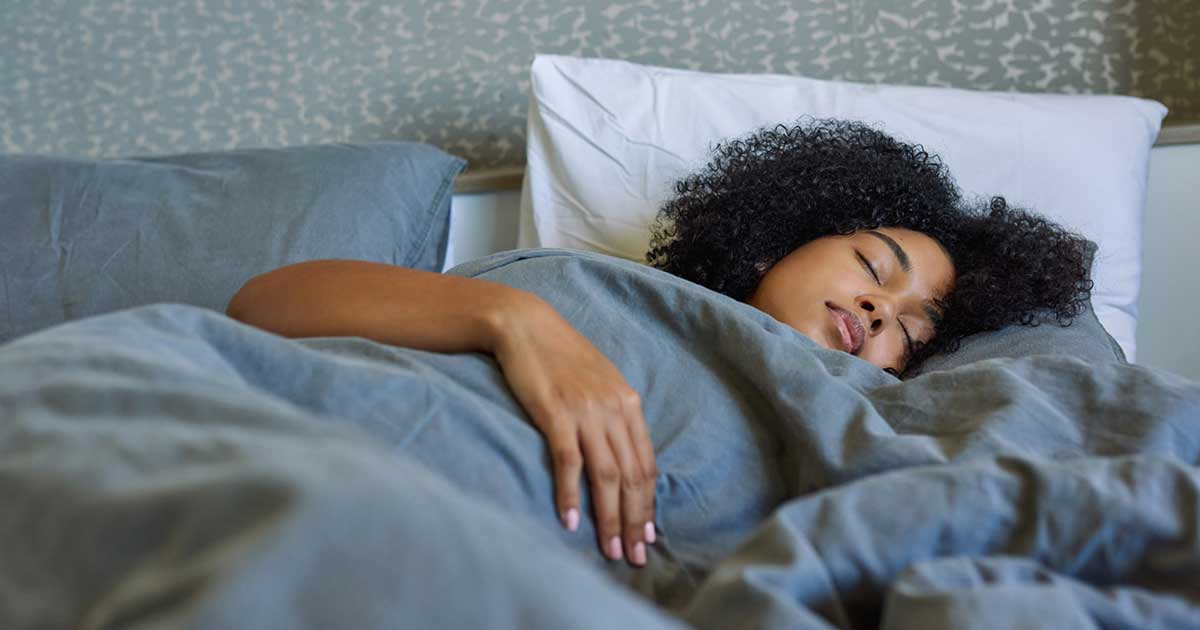10 Stretches to Do Before Bed to Improve Your Sleep
Advice to improve your movement, fitness, and overall health from the world's #1 in orthopedics.
We're all at our best after a restful night's sleep. But convincing our body and mind to turn off for the day can be a challenge. Most people think of lying down as their way of relaxing, says Anna Ribaudo, PT, DPT, OCS, Capp-OB and a clinical lead for the Integrative Care Center at HSS. "But after being so active, you need to transition before going to bed."
She recommends incorporating 10 minutes of gentle stretching into your wind-down routine each night. "I tell my patients to compare themselves to someone running a marathon," she explains. "Your day is like your marathon. It doesn't matter whether you're walking, standing or sitting at a desk, your muscles are being tested. Stretching is a way to relax them so you can rest more comfortably."

If you struggle to fall asleep, stretching may help you to do so more quickly, says Ribaudo. It can also improve blood flow and relieve muscle tension — both of which aid in muscle recovery and sleep quality. The more you can get your body to relax before sleep, the more effective your sleep will be.
"Sleep is the one time your body is at complete rest, when you're not using any muscles or joints to support yourself," says Sheena Alva, PT, DPT, OCS, an orthopedic clinical specialist at HSS. "Stretching before bed helps your body rejuvenate itself during sleep."
It can also help you avoid discomfort during sleep, especially if you're someone who experiences muscle spasms during the day. "Muscles you overuse during the day — especially the neck, calves, hamstrings and quads — can spasm while you're sleeping," Ribaudo says. "If you go from an active state straight to bed, you're more likely to get spasms, which can be intense enough to wake you up."
When and How to Stretch before Bedtime
The best time and place to do nighttime stretches is whenever and wherever you'll do them consistently. Plan to stretch around 30 minutes to an hour before bedtime. "If you wait until the last minute when you're too tired, you'll be more likely to skip it," Ribaudo says. "It shouldn't be the last thing you do before bed but when you're winding down."
To get started, she suggests taking some deep breaths. "If you're anxious and stressed out, take five to 10 minutes to relax your whole system. You'll get more benefit from the stretches."
And as with any stretching, the goal is to gently extend the muscle groups — not to overextend. "The biggest thing to keep in mind when you're stretching is not to push yourself too far," Ribaudo says. "There may be a bit of discomfort but there should not be pain. You should be able to breathe throughout the stretch."
10 Stretches to Do at Bedtime
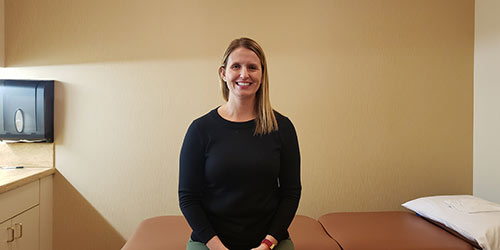
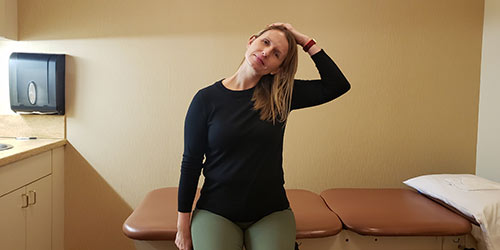
Neck Stretch: This stretch works on the neck and upper trapezius muscles. "During the majority of the day, tension builds up in these muscle groups, in the neck and shoulders — particularly if you're sitting at a desk," Ribaudo says.
- Sit or stand with good posture.
- Keeping your face forward, tip your right ear toward your right shoulder while reaching your left hand toward the floor.
- Gently guide your head towards your right shoulder with your right hand.
- Hold for 20 to 30 seconds.
- Repeat two to three times on the right, then switch sides and repeat.
Tip: Use a mirror to ensure you're starting in a neutral position, with your neck in line with your body.
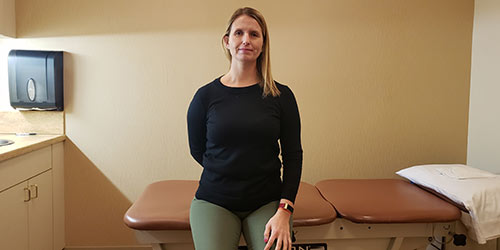
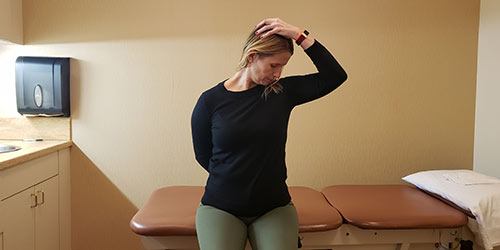
Neck Twist: This stretch, which targets the scapula, can also help people who sit all day, Ribaudo says.
- Place your right hand on your tailbone, palm facing out.
- Bend your neck to the left, turning your head down toward your left hip.
- Gently guide your head toward your left hip with your left hand while reaching your right hand down.
- Hold for 20 to 30 seconds.
- Repeat two to three times on the left, then switch sides and repeat.
Tip: Placing a hand on your tailbone anchors you for a fuller stretch.
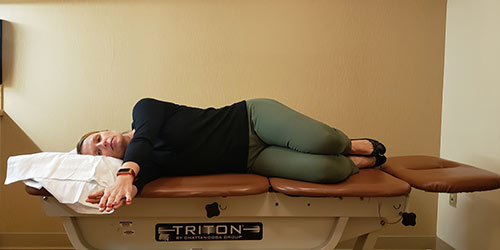
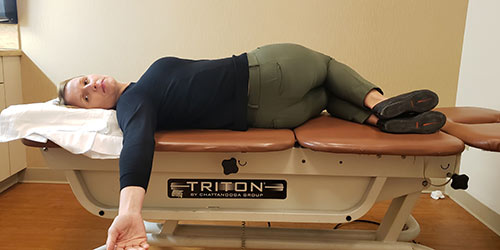
Lying "T" Twist: This rotation targets the thoracic spine, or upper back. "It's a great way to open up the whole spine," Ribaudo says. "It helps with tightness in the hips, neck or pecs."
- Lie on your right side with arms on top of each other, legs bent, and knees on top of each other.
- Slide your left (top) arm across your body as you rotate your upper body and head to the left.
- Hold in a "T" position for 10 seconds, then rotate back to the stacked position.
- Repeat three to five times on the left, then switch sides and repeat.
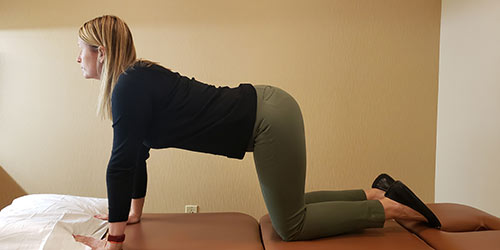

Cat-Cow: This stretch targets the lower back, which can get stiff from sitting, standing or walking. "Most people don't necessarily bend forward or backward properly, but when you're on your hands and knees, you're in an unweighted position, so there's no risk of doing it wrong," Ribaudo says.
- Get onto your hands and knees with your hands under your shoulders and knees under hips. (This is your neutral position.)
- Arch your back by tightening your abdominal muscles, squeezing your buttocks and tucking in your tailbone ("cat").
- Hold this position for 10 seconds.
- Let your lower back sag toward the floor, rotate your tailbone upwards and stretch the front of your neck ("cow").
- Hold this position for 10 seconds.
- Return to the neutral position and repeat five to 10 times.
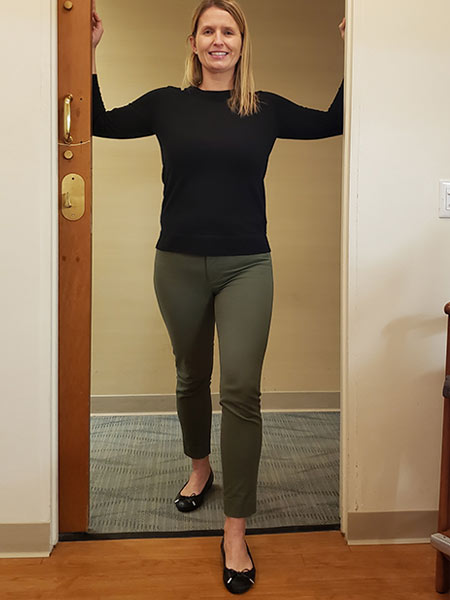
Assisted Chest Stretch: "Even people with great posture round their shoulders," says Ribaudo, which can lead to stiffness in the front of the chest. This stretch works on the pectorals and anterior deltoid muscles — the chest and shoulders.
- Stand in a doorframe with your forearms positioned flat on the doorframe and your shoulders and elbows at right angles.
- Lean forward until you feel a stretch in the front of your chest and upper shoulders.
- Hold for 30 seconds.
- Repeat two to three times.
Tip: You should not arch or feel any strain in your lower back.
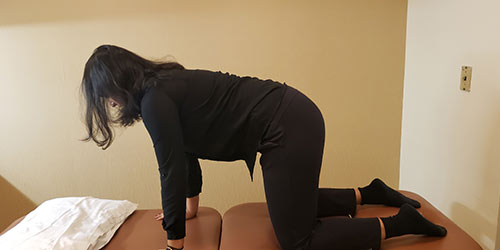
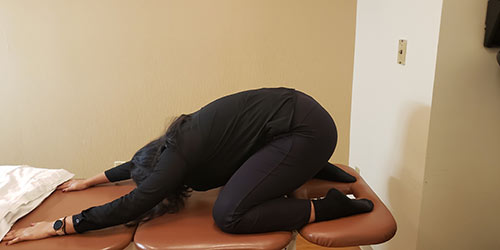
Child's Pose: This stretch relieves tension in the lower back and stretches the glutes and upper body, which allows for normal spinal alignment, says Ribaudo.
- From your hands and knees (neutral), slowly lower your butt toward your feet.
- Hold for 30 seconds.
- Return to neutral and repeat three times.
Tip: Focus on moving your butt toward your heels. "The biggest thing that people do wrong is trying to get their head or chest to touch the floor," Ribaudo says. "That will cause more strain than relaxation in the lower-to-middle back."
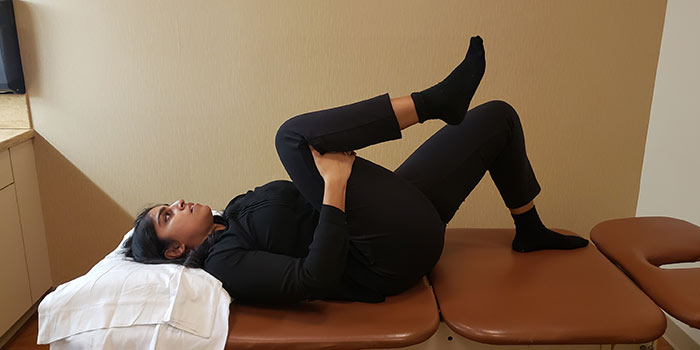
Lying Single Knee to Chest: This stretch is mainly for the hips, but also helps the glutes, back, neck and shoulders to open up.
- Lying on your back with your legs extended, bring your right knee up and hold behind it with both hands.
- Gently pull your knee toward your chest.
- Hold for 30 seconds.
- Repeat three times on the right, then switch sides and repeat.
Tip: If you feel discomfort in your lower back during this stretch, bend your opposite leg to support your pelvis.
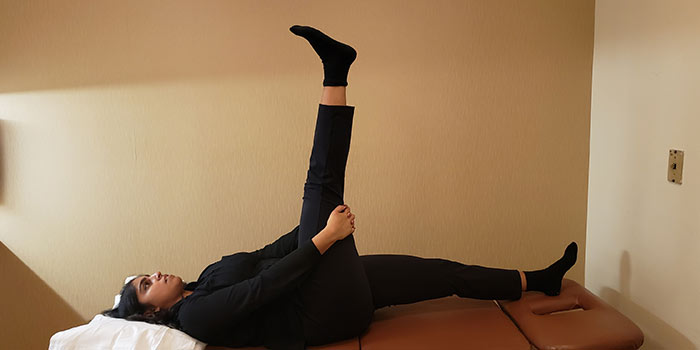
Supine Hamstring Stretch: "The hamstrings are such a big muscle group that we use constantly — sitting, standing, walking — and often neglect, which can limit our movement and cause strain on the joints," Alva says. In addition to the hamstrings, this stretch can help relax the calves as well.
- Lying on your back with your legs extended, lift your right leg straight up and grasp the back of your right calf with both hands.
- Hold for 30 seconds.
- Lower the leg down.
- Repeat three times on the right, then switch sides and repeat.
Tip: Keep the leg you're stretching as straight as possible, as that's more important than how high you can get it. A strap can be very helpful, if you have one; position it around your foot to gently pull your leg back and increase the stretch.

Standing Quad Stretch: This stretch targets the quads, or the front of the thighs, a large muscle group that gets a lot of use —whenever you're on your feet, climbing stairs or getting in and out of chairs. "This is a simple stretch to do throughout the day, but it's especially important to do before you go to bed," Alva says.
- From a standing position, bend your right knee, holding your ankle or foot with your right hand behind you.
- Gently pull your foot toward your butt until you feel a stretch in the front of your thigh.
- Hold for 30 seconds.
- Lower your leg down.
- Repeat three times on the right, then switch sides and repeat.
Tip: Keep your bent knee in line with your straight leg. "Stand nice and tall," Alva says. "You shouldn't bend forward or backward."
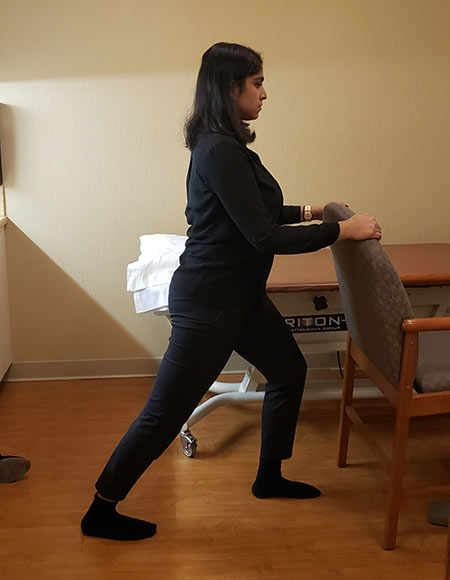
Standing Calf Stretch: The calves are another big area we tend to neglect, Alva says. "Every step we take, whenever we're standing, the calves are turned on. Everyone's calves are tight."
- Stand facing a wall with your right foot forward and your left behind you, toes on both feet pointing forward.
- With your front leg bent and your rear leg straight, lean forward, placing your hands on the wall in front of you.
- Gently bend your front leg more deeply until you feel a stretch in the back of your rear leg, controlling the intensity of the stretch by moving closer to or farther from the wall.
- Hold for 30 seconds.
- Straighten your front leg to return to a neutral position.
- Repeat three times, then switch sides and repeat.
Tips: Keep your toes pointing forward and the heel of your rear foot on the floor.


